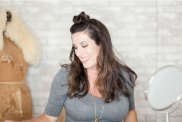What more do you need to know about head lice then they are gross, right? While most moms would agree that head lice are gross, it’s unfortunately all too common a problem.
While anyone can get head lice, it’s a very common problem for children ages 3 to 12.
What are head lice?
Head lice is the plural of head louse, a parasite that lives in human hair and survives by eating small amounts of blood from the human scalp. These wingless bugs are tiny, but you can see them with the naked eye with the aid of a bright light. When head lice bite your child’s scalp, it becomes itchy and inflamed. Persistent scratching can cause irritation and in some cases, infection. While head lice aren’t dangerous and don’t spread infection or disease, they are super contagious and extremely annoying. Head lice spread by crawling on hair and can spread from head to head contact or by sharing personal items.
Signs of head lice
If your child starts itching her scalp, you may want to check for head lice. When checking for head lice, part your child’s hair into small sections and look closely at your child’s scalp. If your child has head lice you may see:
Lice eggs, aka nits. Nits are yellow, tan or brown eggs that are found close to the scalp. They resemble dandruff, but they can’t be shaken off. Lice eggs hatch about 1 to 2 weeks after they are laid on the scalp. The good news is that you’re more likely to find nits that live lice in your child’s hair.
Adult and baby lice aka nymphs. Lice are the size of a sesame seed or smaller and are grey, white or tan in color.
Red Small bumps. Head lice can cause a rash and persistent itching can cause irritation.
If you don’t see anything and your child is still itching her scalp regularly, you may wish to have her checked for head lice by her doctor since head lice can be hard to detect.
What to do if you suspect head lice?
If you’ve inspected your child’s head and believe she may have head lice, you’ll want to contact your child’s doctor. You’ll also want to alert your child’s school and/or day care center. In addition to finding out if anyone else has recently been treated for head lice, you’ll want to let the school or center know that your child does have an infestation since head lice is highly contagious.
Treatment for head lice
There are a few options for the treatment of head lice. A fine-tooth comb can be purchased to help manually remove the nits or over the counter and prescription shampoos and rinses can be used to kill the head lice. For children under 2, medicated treatments should not be used.
To remove nits by hand, you’ll need to use a fine-tooth comb on your child’s wet and conditioned hair. You’ll need to repeat this every 3 to 4 days for 2 weeks after the last live louse was detected.
If using an over the counter or medicated treatment, you must follow all instructions carefully.
Disinfecting the home
While head lice doesn’t live long after it has fallen off the scalp, some precautions should be taken to remove head lice from the home. All bed linens and clothing the child has recently worn should be washed in hot water and then placed into a hot dryer for at least 20 minutes. Carpets and furniture should be vacuumed and all hair care items and accessories should be discarded and replaced.
Preventing Lice
While it’s a common misconception that head lice is a sign of poor hygiene, it really isn’t. Anyone can get head lice. To prevent head lice in your children, teach them to avoid head to head contact, to avoid sharing personal items and hair accessories, and to avoid laying on pillows or carpets that have been used by someone recently infected with lice.








